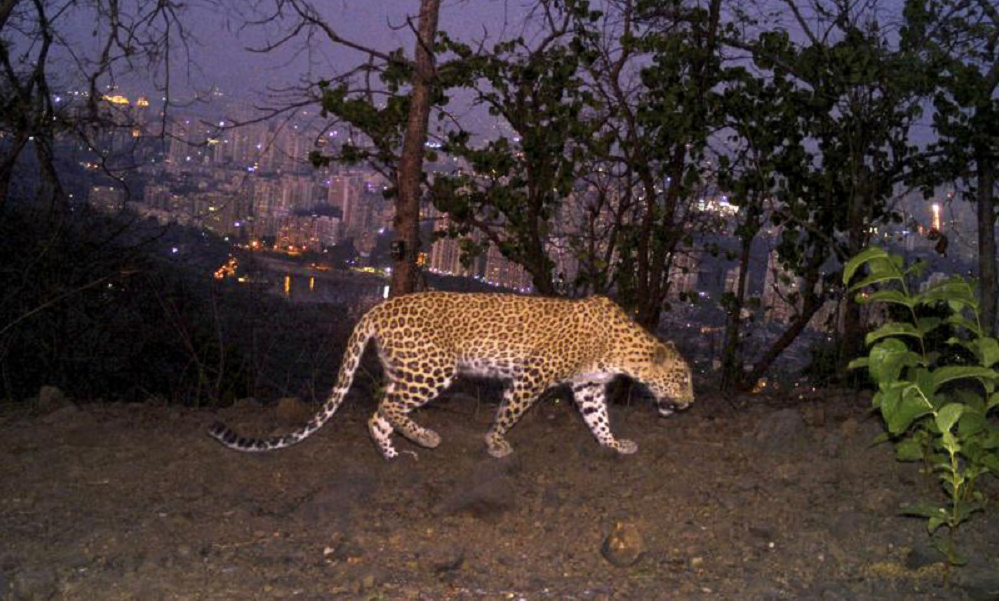Science & Technology
Big cats in urban jungle: LA mountain lions, Mumbai leopards

Los Angeles and Mumbai, India, are the world’s only megacities of 10 million-plus people where large felines — mountain lions in one, leopards in the other — thrive by breeding, hunting and maintaining territory within urban boundaries.
Long-term studies in both cities have examined how the big cats prowl through their urban jungles, and how people can best live alongside them — lessons that may be applicable to more places in coming decades, AP reported.
“In the future, there’s going to be more cities like this, as urban areas further encroach on natural habitats,” said biologist Audra Huffmeyer, who studies mountain lions at the University of California, Los Angeles. “If we want to keep these large carnivores around on the planet, we have to learn to live with them.”
Twenty years ago, scientists in Los Angeles placed a tracking collar on their first cat, a large male mountain lion dubbed P1, that defended a wide swath of the Santa Monica Mountains, a coastal range that lies within and adjacent to the city.
“P1 was as big as they get in southern California, about 150 pounds,” said Seth Riley, a National Park Service ecologist who was part of the effort. “These dominant males are the ones that breed — they won’t tolerate other adult males in their territory.”
With GPS tracking and camera traps, the scientists followed the rise and fall of P1’s dynasty for seven years, through multiple mates and litters of kittens. “2009 was the last time we knew anything about P1,” said Riley. “There must have been a fight. We found his collar, blood on a rock. And never saw him again. He was reasonably old.”
Since then, Riley has helped collar around 100 more mountain lions in Los Angeles, building a vast database of lion behavior that’s contributed to understanding how much territory the cats need, what they eat (mostly deer), how often they cross paths with people and what may imperil their future, AP reported.
In Mumbai, one of the world’s most densely populated cities, the leopards are packed in, too: about 50 have adapted to a space ideally suited for 20. And yet the nocturnal cats also keep mostly out of sight.
“Because these animals are so secretive, you don’t know much about them. You can’t just observe them,” said Vidya Athreya, director of Wildlife Conservation Society in India and part of a research team that recently fitted five leopards with tracking collars.
The leopards’ core range is centered around Sanjay Gandhi National Park, a protected area boxed on three sides by an urbanized landscape, including a neighborhood that’s home to 100,000 people and nearly a dozen leopards, AP reported.
Researchers tackled specific questions from park managers, such as how the cats cross busy roads near the park.
To get the answer, they collared a big male dubbed Maharaja. They found that it walked mostly at night and traversed over 60 kilometers in about a week, from the park in Mumbai to another nearby. The leopard crossed a busy state highway, using the same spot to pass, on three occasions. It also crossed a railway track.
The path chosen by Maharaja is nearby a new highway and a freight corridor under construction. Researchers said that knowing the big cats’ highway crossing habits can help policy makers make informed decisions about where to build animal underpasses to reduce accidents.
But learning to live alongside cats is not only a matter of infrastructure decisions, but also human choices and education, AP reported.
In Mumbai, Purvi Lote saw her first leopard when she was 5, on the porch of a relative’s home. Terrified, she ran back inside to her mother. But now the 9-year-old says she isn’t as afraid of the big cats.
Like other children, she doesn’t step outdoors alone after dark. Children and even adults travel in groups at night, while blaring music from their telephones to ensure that leopards aren’t surprised. But the most fundamental rule, according to the youngster: “When you see a leopard, don’t bother it.”
Leopards in Mumbai adapted to mainly hunt feral dogs that frequent garbage dumps outside the forest and mostly attacked people when cornered or attacked. But in 2010, 20 people in Mumbai died in leopard attacks, said Jagannath Kamble, an official at Mumbai’s protected forest.
Officials roped in volunteers, nongovernmental groups and the media for a public education program in 2011. Since then, fatalities have dropped steadily and no one has been killed in an attack since 2017, AP reported.
In Los Angeles, there have been no human deaths attributed to mountain lions, but one nonfatal attack on a child occurred in 2021.
Both cities have learned that trying to capture, kill or relocate the cats isn’t the answer, AP reported.
“Relocation and killing makes conflict worse,” said Beth Pratt, California regional director at National Wildlife Federation. “It’s better to have a stable population, than one where hierarchies and territories are disrupted.”
Avoidance is the safest strategy, she said. “These big cats are shy — they tend to avoid human contact as much as they can. They’re really extreme introverts of the animal kingdom.”
Science & Technology
Apple loses top phonemaker spot to Samsung as iPhone shipments drop, IDC says

Apple’s (AAPL.O), opens new tab smartphone shipments dropped about 10% in the first quarter of 2024, hurt by intensifying competition by Android smartphone makers aiming for the top spot, data from research firm IDC showed on Sunday.
Global smartphone shipments increased 7.8% to 289.4 million units during January-March, with Samsung (005930.KS), opens new tab, at 20.8% market share, clinching the top phonemaker spot from Apple, Reuters reported.
The iPhone-maker’s steep sales decline comes after its strong performance in the December quarter when it overtook Samsung as the world’s No.1 phone maker. It’s back to the second spot, with 17.3% market share, as Chinese brands such as Huawei gain market share.
Xiaomi, one of China’s top smartphone makers, occupied the third position with a market share of 14.1% during the first quarter, read the report.
South Korea’s Samsung, which launched its latest flagship smartphone lineup – Galaxy S24 series – in the beginning of the year, shipped more than 60 million phones during the period.
Global sales of Galaxy S24 smartphones jumped 8%, compared to last year’s Galaxy S23 series during their first three weeks of availability, data provider Counterpoint previously said.
In the first quarter, Apple shipped 50.1 million iPhones, down from 55.4 million units it shipped same period last year, according to IDC.
Apple’s smartphone shipments in China shrank 2.1% in the final quarter of 2023 from a year earlier.
The drop underscores the challenges facing the U.S. firm in its third biggest market, as some Chinese companies and government agencies limit employees’ use of Apple devices, a measure that mirrors U.S. government restrictions on Chinese apps on security grounds.
The Cupertino, California-based company in June will hold its Worldwide Developers Conference (WWDC), where it will highlight updates to the software powering iPhones, iPads, and other Apple devices.
Investors are closely watching for updates on artificial intelligence development at Apple, which has so far spoken little about incorporating the AI technology into its devices. The company earlier this year lost the crown as the world’s most valuable company to Microsoft (MSFT.O), opens new tab, Reuters reported.
Science & Technology
China launch of relay satellite Queqiao-2 for lunar probe mission successful

China National Space Administration (CNSA) said on Friday its launch of a key signal relay satellite was a “complete success” and it would serve as the communication bridge for its future lunar probe missions for years to come, state media reported.
China launched the satellite Queqiao-2, which was named after a mythological bridge made of magpies, and two miniature satellites, Tiandu-1 and Tiandu-2, on March 20.
Queqiao-2 will be used as a communications bridge between the ground operations on earth and upcoming lunar probe missions on the far side of the moon until at least 2030.
The moon’s near side always faces earth. That means data transfers from the far side are impossible because there is no direct line of sight.
Queqiao-2 researcher and developer Xiong Liang described the satellite as “the main switch” of the whole fourth phase of lunar missions, according to state television CCTV.
“Only when the main switch is flipped on, all the communications can kick off,” Xiong said.
Queqiao-2 will orbit the moon and relay signals to and from the Chang’e-6 mission, which expected to be launched in May. The robotic Chang’e-6 probe will seek to retrieve samples from an ancient basin, acquiring lunar material from the moon’s hidden side for the first time.
Queqiao-2 will also be used as a relay platform for the Chang’e-7 lunar mission in 2026 and the Chang’e-8 mission in 2028.
The functions and performance of Queqiao-2 met mission requirements and it will be able to provide relay communication services for China’s lunar exploration projects and future lunar missions for China and other countries, said the CNSA, according to CCTV.
Queqiao-2 entered its targeted elliptical orbit on April 2 after a correction midway, near-moon braking and orbital manoeuvre around the moon, CNSA said.
The satellite has successfully communicated with Chang’e 4, which was the first spacecraft to perform a soft landing on the far side of the moon and is still carrying out its exploration mission. It also communicated with the Chang’e-6 probe while it is still on the ground earlier this month.
The successful launch of Queqiao-2 comes after the failed launch of another lunar spacecraft DRO-A/B satellites, which was intended to enter the moon’s distant retrograde orbit (DRO).
China has not released any information on whether or not the satellites can be retrieved.
(Reuters)
Science & Technology
Russia aborts planned test launch of new heavy-lift space rocket

Russian space officials on Tuesday aborted the test launch of a new heavy-lift rocket from its far-eastern launch pad.
The Angara-A5 rocket was scheduled to lift off from the Vostochny space launch facility at 0900 GMT Tuesday, but the launch was aborted two minutes before, AP reported.
Yuri Borisov, head of Roscosmos state space corporation, said the automatic safety system canceled the launch after registering a flaw in the oxidizer tank pressurization system.
He said the next launch attempt was set for Wednesday.
Tuesday’s launch was to be the fourth for the Angara-A5, a heavy-lift version of the new Angara family of rockets that has been developed to replace the Soviet-designed Proton rockets.
-

 Sport5 days ago
Sport5 days agoAfghanistan Champions League kicks off with grand opening ceremony
-

 Latest News4 days ago
Latest News4 days agoPakistan’s frontiers minister stresses ‘dignified’ return of Afghan refugees
-

 Latest News5 days ago
Latest News5 days agoMore than 800 Afghan refugees deported from Pakistan in two days
-

 Regional3 days ago
Regional3 days agoIranian president lands in Pakistan for three-day visit to mend ties
-

 Climate Change4 days ago
Climate Change4 days agoMassive river flooding expected in China, threatening millions
-

 Latest News4 days ago
Latest News4 days agoChinese keen to invest in Panjshir-Kabul water conduit project
-

 World4 days ago
World4 days agoTwo Japan navy helicopters crash, one body found, 7 missing
-

 Sport3 days ago
Sport3 days agoKolkata beat Bengaluru by one run in IPL as Kohli fumes at dismissal
























